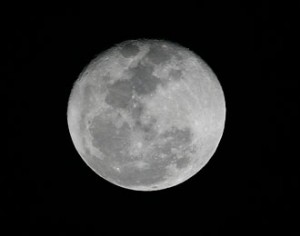The Moon, Earth’s celestial companion, has long captivated human imagination and scientific inquiry. Its luminous visage has adorned countless myths and legends, yet contemporary investigations have begun to unravel a more tangible enigma: the compelling assertion that the Moon is, in fact, shrinking. This remarkable hypothesis has sparked intrigue, prompting exploratory questions regarding the Moon’s geological dynamics and its broader implications for lunar astrophysics. What does it mean for our understanding of this orbital treasure? How might one reconcile such findings with the cultural and scientific narratives that have shaped our perceptions of the Moon?
The notion of a diminishing lunar mass necessitates a strong comprehension of two fundamental principles: the formation of the Moon and the subsequent thermal evolution of its interior. Formed approximately 4.5 billion years ago, the Moon is believed to be the result of a colossal impact between a Mars-sized body and the primordial Earth. This cataclysmic event released an immense amount of energy, causing the ejection of molten material that coalesced into the Moon we observe today. The initial conditions were rife with heat, and as the Moon began to cool, its surface solidified while its interior remained somewhat malleable.
Over eons, the cooling process led to the development of what is known as ‘thermal contraction.’ As the Moon’s interior continued to cool, it began to undergo shrinkage, resulting in the formation of myriad fractures and scarps on its surface. The presence of these geological features displays a tangible history of the Moon’s dynamic geological processes. It can be likened to a drying clay sculpture: as moisture evaporates, the clay contracts and may even crack, revealing a complex structure beneath.
Recent scientific advancements have provided alarming data that seem to corroborate this shrinking hypothesis. Lunar Reconnaissance Orbiter (LRO) missions have yielded high-resolution imagery that displays substantial evidence of surface deformation, including linear features known as ‘thrust faults.’ These faults serve as indicators of tectonic activity, suggesting that the Moon is not merely a dead body but an entity experiencing ongoing geological processes. The realization that the Moon is still alive, albeit in a muted capacity, challenges the long-held assumption of its geological inactivity.
Indeed, the lunar surface is dotted with numerous ridges, indicating that the Moon is experiencing a contraction of its crust, a process that could also invite speculation on its internal structure, including the presence of a potentially molten core. The combination of these geological markers paints a vivid portrait of a once-active satellite undergoing evolution, albeit at a much slower rate than the tumultuous events of its infancy.
This discovery prompts intriguing inquiries regarding the Moon’s future. Could the process of shrinkage lead to more than mere surface fractures? It opens a Pandora’s box of possibilities: how might this contraction influence future lunar exploration and colonization efforts? To ensure safe, sustainable human habitation, understanding the Moon’s geological instability becomes imperative. Will future missions need to accommodate for potential seismic activity? The implications echo loudly in the halls of lunar science and exploration.
Furthermore, one must contemplate the broader repercussions this shrinkage may have on our understanding of planetary development within the solar system. The Moon is often regarded as a model for understanding terrestrial bodies, particularly when studying the history of other celestial satellites. If our Moon retains geological activity, it beckons a reevaluation of other ‘dead’ celestial bodies, challenging preconceived notions surrounding their evolutionary timelines. Could we observe similar contraction on other moons, thus prompting a paradigm shift in our comprehension of planetary formation?
The phenomenon also invites an exploration of the interplay between the Moon and Earth. Tidal forces exerted by the Earth upon the Moon generate friction that could influence thermal gradients within the lunar interior. Understanding how these tidal forces might exacerbate or mitigate the shrinkage of the Moon poses an interesting challenge. Are we then, through our very existence on Earth, exerting an influence that could accelerate lunar geological activity? Such perspectives underscore the intricate relationships that exist within celestial mechanics, wherein one body may inexorably affect another.
Despite the gravitas of these findings, it is essential to navigate the narrative with prudence and scientific rigor. While shrinking implies a definitive action, it is crucial to contextualize this in temporal scales that span millions of years. The Moon’s current state prompts a need for extensive further research, considering additional factors such as its orbital dynamics and potential external influences from other celestial bodies. Researchers must utilize a multifaceted approach, integrating findings from geology, seismology, and planetary science, to fully unravel the dimensions of this fascinating narrative.
As we continue to scrutinize and interpret the data, the advocacy for deeper exploratory missions is paramount. Future investigations, particularly those utilizing more sophisticated technologies, could yield insight into the Moon’s evolving geology, perhaps even unearthing more secrets hidden beneath its dusty regolith. It is becoming crystal clear: the Moon is not a static relic but an evolving component of our cosmic neighborhood.
In conclusion, the announcement that the Moon is shrinking redefines our understanding of our closest celestial neighbor and instigates a cascade of questions regarding lunar geology, astrophysical interactions, and the nature of planetary bodies in our solar system. The implications stretch far beyond the lunar surface, challenging the boundaries of our knowledge and opening Pandora’s box to exciting scientific endeavors that lie ahead. As we transition into a new era of lunar exploration, the whimsical query lingers: how much of a role do we play in the Moon’s evolution? Only time, and continued inquiry, will reveal the answers.












